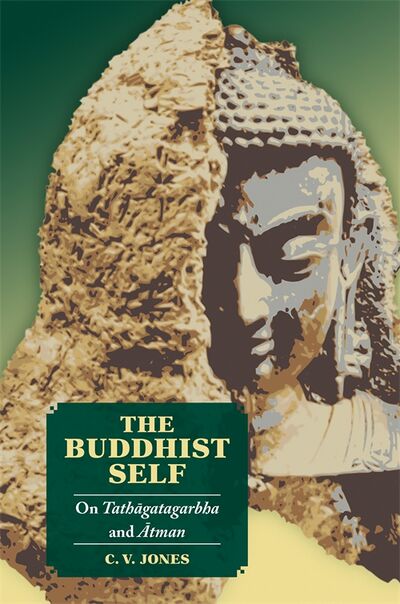No edit summary |
No edit summary |
||
| (4 intermediate revisions by 2 users not shown) | |||
| Line 1: | Line 1: | ||
{{Book | {{Book | ||
|TileDescription=A methodical examination of Indian teaching about the ''tathāgatagarbha'' (“Buddha-nature”) and foundational Buddhist teachings about 'not-self' (''anātman''). In 2021 ''The Buddhist Self'' was awarded the Toshihide Numata Book Award. | |||
|BookPerson={{Book-person | |BookPerson={{Book-person | ||
|PersonPage=Jones, Christopher | |PersonPage=Jones, Christopher | ||
| Line 5: | Line 6: | ||
}} | }} | ||
|FullTextRead=No | |FullTextRead=No | ||
|VideoService=youtube | |||
|VideoId=Iu1YnEaEvWo | |||
|BookToc=**{{i|ACKNOWLEDGMENTS|XI}} | |BookToc=**{{i|ACKNOWLEDGMENTS|XI}} | ||
**{{i|ABBREVIATIONS|VIII}} | **{{i|ABBREVIATIONS|VIII}} | ||
| Line 14: | Line 17: | ||
**{{i|1.3 Essences, Natures, Wombs, and Chambers|14}} | **{{i|1.3 Essences, Natures, Wombs, and Chambers|14}} | ||
**{{i|1.4 Buddhist ''Ātmavāda:'' Preliminary Thoughts|21}} | **{{i|1.4 Buddhist ''Ātmavāda:'' Preliminary Thoughts|21}} | ||
'''Part I: Buddha-Nature, the Self'''<br> | '''Part I: Buddha-Nature, the Self'''<br> | ||
*{{i|2 The ''Mahāparinirvāṇamahāsūtra'' and the Buddhist Self|29}} | *{{i|2 The ''Mahāparinirvāṇamahāsūtra'' and the Buddhist Self|29}} | ||
**{{i|2.1 The Text|29}} | **{{i|2.1 The Text|29}} | ||
| Line 54: | Line 57: | ||
**{{i|5.5 Conclusions|136}} | **{{i|5.5 Conclusions|136}} | ||
6 | *{{i|6 Other ''Tathāgatagarbha'' Sources|139}} | ||
6.1 The ''Anūnatvāpūrṇatvānirdeśaparivarta'' | **{{i|6.1 The ''Anūnatvāpūrṇatvānirdeśaparivarta''|139}} | ||
6.2 The ''Tathāgatagarbhasūtra'' | **{{i|6.2 The ''Tathāgatagarbhasūtra''|143}} | ||
6.3 The Mahāyānasūtrālaṃkāra'' | **{{i|6.3 The ''Mahāyānasūtrālaṃkāra''|148}} | ||
7 | *{{i|7 The ''Ratnagotravibhāga'' and the Self That Is No Self|154}} | ||
7.1 The Text | **{{i|7.1 The Text|154}} | ||
7.2 Buddha-nature and the "Basic" RGV | **{{i|7.2 Buddha-nature and the "Basic" RGV|158}} | ||
7.3 "Perfection of Self' in the RGVV | **{{i|7.3 "Perfection of Self' in the RGVV|167}} | ||
7.4 ''Tathāgatagarbha'' as, Once Again, the Self | **{{i|7.4 ''Tathāgatagarbha'' as, Once Again, the Self|175}} | ||
7.5 Conclusions | **{{i|7.5 Conclusions|178}} | ||
8 | *{{i|8 The ''Laṅkāvatārasūtra'' and Rejecting the Buddhist Self|181}} | ||
8.1 The Text | **{{i|8.1 The Text|181}} | ||
8.2 ''Tathāgatagarbha'' and Absence of Self | **{{i|8.2 ''Tathāgatagarbha'' and Absence of Self|183}} | ||
8.3 The ''"Ālayavijñāna-Tathāgatagarbha"'' | **{{i|8.3 The ''"Ālayavijñāna-Tathāgatagarbha"''|188}} | ||
8.4 Selfhood in the ''Sagāthaka'' | **{{i|8.4 Selfhood in the ''Sagāthaka''|191}} | ||
8.5 Conclusions | **{{i|8.5 Conclusions|194}} | ||
8.6 Postscript: After the LAS | **{{i|8.6 Postscript: After the LAS|195}} | ||
'''Part III: Buddha-nature Reconsidered'''<br> | '''Part III: Buddha-nature Reconsidered'''<br> | ||
9 | *{{i|9 Recurring Themes and Motifs|203}} | ||
9.1 The Single Vehicle | **{{i|9.1 The Single Vehicle|203}} | ||
9.2 "Cryptic" Utterances | **{{i|9.2 "Cryptic" Utterances|210}} | ||
9.3 The Intrinsically Pure Mind | **{{i|9.3 The Intrinsically Pure Mind|214}} | ||
9.4 "Sarvalokapriyadarśana" | **{{i|9.4 "Sarvalokapriyadarśana"|217}} | ||
9.5 Emptiness and Nonemptiness | **{{i|9.5 Emptiness and Nonemptiness|218}} | ||
9.6 Non-Buddhists and Their Teachings | **{{i|9.6 Non-Buddhists and Their Teachings|223}} | ||
10 | *{{i|10 Evolution of the Buddhist Self|229}} | ||
10.1 The Course of Buddha-nature Teaching | **{{i|10.1 The Course of Buddha-nature Teaching|229}} | ||
10.2 Origins of the Buddha-nature Idea | **{{i|10.2 Origins of the Buddha-nature Idea|237}} | ||
10.3 Liberation and the Self | **{{i|10.3 Liberation and the Self|245}} | ||
10.4 Buddhist Selfhood and the Mahāyāna | **{{i|10.4 Buddhist Selfhood and the Mahāyāna|253}} | ||
10.5 Closing Thoughts | **{{i|10.5 Closing Thoughts|261}} | ||
REFERENCES | **{{i|REFERENCES|265}} | ||
INDEX | **{{i|INDEX|287}} | ||
| | |||
|PublisherLogo=File:University of Hawai'i Press Logo.png | |PublisherLogo=File:University of Hawai'i Press Logo.png | ||
|ExtraCategories=University of Hawai'i Press | |ExtraCategories=University of Hawai'i Press | ||
|StopPersonRedirects=No | |StopPersonRedirects=No | ||
|AddRelatedTab=No | |||
}} | }} | ||
Latest revision as of 11:41, 22 September 2021
The assertion that there is nothing in the constitution of any person that deserves to be considered the self (ātman)—a permanent, unchanging kernel of personal identity in this life and those to come—has been a cornerstone of Buddhist teaching from its inception. Whereas other Indian religious systems celebrated the search for and potential discovery of one’s “true self,” Buddhism taught about the futility of searching for anything in our experience that is not transient and ephemeral. But a small yet influential set of Mahāyāna Buddhist texts, composed in India in the early centuries CE, taught that all sentient beings possess at all times, and across their successive lives, the enduring and superlatively precious nature of a Buddha. This was taught with reference to the enigmatic expression tathāgatagarbha—the “womb” or “chamber” for a Buddha—which some texts refer to as a person’s true self.
The Buddhist Self is a methodical examination of Indian teaching about the tathāgatagarbha (otherwise the presence of one's “Buddha-nature”) and the extent to which different Buddhist texts and authors articulated this in terms of the self. C. V. Jones attends to each of the Indian Buddhist works responsible for explaining what is meant by the expression tathāgatagarbha, and how far this should be understood or promoted using the language of selfhood. With close attention to these sources, Jones argues that the trajectory of Buddha-nature thought in India is also the history and legacy of a Buddhist account of what deserves to be called the self: an innovative attempt to equip Mahāyāna Buddhism with an affirmative response to wider Indian interest in the discovery of something precious or even divine in one's own constitution. This argument is supplemented by critical consideration of other themes that run through this distinctive body of Mahāyānist literature: the relationship between Buddhist and non-Buddhist teachings about the self, the overlap between the tathāgatagarbha and the nature of the mind, and the originally radical position that the only means of becoming liberated from rebirth is to achieve the same exalted status as the Buddha. (Source: University of Hawai'i Press)
| Citation | Jones, Christopher V. The Buddhist Self: On Tathāgatagarbha and Ātman. Honolulu: University of Hawai'i Press, 2020. |
|---|---|


